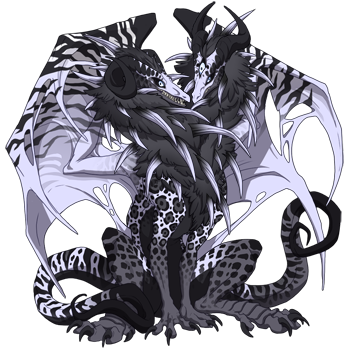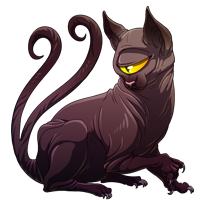

Strix
(#84504756)
accursed, ill-omened, man-eater crying out for strife
Click or tap to view this dragon in Predict Morphology.
Energy: 50/50

Expand the dragon details section.
Collapse the dragon details section.
Personal Style

Ancient dragons cannot wear apparel.
Skin
Scene

Measurements
Length
4.81 m
Wingspan
7.86 m
Weight
334.6 kg
Genetics
Orca
Jaguar (Aberration)
Jaguar (Aberration)
Orca
Safari (Aberration)
Safari (Aberration)
Orca
Fangs (Aberration)
Fangs (Aberration)
Hatchday
Breed
Eye Type
Level 1 Aberration
EXP: 0 / 245


STR
7
AGI
8
DEF
6
QCK
6
INT
5
VIT
8
MND
5
Biography
The strix (plural striges or strixes; στρίξ, στριγός), in the mythology of classical antiquity was a bird of ill omen, the product of metamorphosis, that fed on human flesh and blood. The striges also came to mean witches and other malevolant supernatural beings like vampires. One paper speculates that this meaning is as old as the 4th century BCE, on the basis that in the origin myth of Polyphontes, attributed to 4th century BCE Greek author Boios. But more concrete examples occur in Ovid's Fasti (early 1st century CE) where the striges as transformations of hags is offered as one possible explanation, and Sextus Pompeius Festus (fl. late 2nd century) who glossed striges as "women who practice witchcraft" "(maleficis mulieribus)" or "flying women" ("witches" by transference).
The Latin strix comes from Ancient Greek στρίξ (stríx, “screecher”). The strix is initially described as a large-headed bird with transfixed eyes, rapacious beak, greyish white wings, and hooked claws in Ovid's Fasti. This is the only thorough description of the strix in Classical literature, and elsewhere, it is only described as being dark-coloured. The strix was a nocturnally crying creature which positioned its feet upwards and head below, according to Boios myth. It is probably meant to be (and translated as) an owl, but is highly suggestive of a bat which hangs upside-down.
The strix in later folklore was a bird which squirted milk upon the lips of (human) infants. Pliny in his Natural History dismissed this as nonsense and remarked it was impossible to establish what bird was meant by this. The same habit, where the strix lactates foul-smelling milk onto an infant's lips is mentioned by Titinius, who noted the placement of garlic on the infant was the prescribed amulet to ward against it. In the case of Ovid's striges, they threatened to do more harm than that. They were said to disembowel an infant and feed on its blood. Ovid allows the possibilities of the striges being birds of nature, or products of magic, or transformations by witches using magical incantations.
According to Antoninus Liberalis's Metamorphoses, the strīx (στρίξ) was a metamorphosis of Polyphonte; she and her bear-like sons Agrios and Oreios were transformed into birds as punishment for their cannibalism. The ill-omened strix herself did not perpetrate harm on humans, but was guilty by association with her murderous sons. This Greek tale only survives in the form as recorded by Antoninus who flourished 100–300 CE, but it preserved the older tale from the lost Ornithologia by Boios. Here the strix is described as (a bird) "that cries by night, without food or drink, with head below and tips of feet above, a harbinger of war and civil strife to men".
While the myth of striges is claimed to have originated in ancient Greece, some studies are critical of the idea and instead note a widespread belief in ancient Italy of a "bloodthirsty monsters in bird form." They theorize that the notion of striges originated in Italy and was later borrowed by the Greeks, along with the the concept of strix as witches, which was articulated in Ovid; one scholar estimates the Greeks adopted the strix as "child-murdering horrors" by the "last centuries BCE". The modern Greek form στρίγλα may betray an influence of a Latin diminutive strigula.
The first Latin allusion is in Plautus' comedy Pseudolus dated to 191 BCE, in which an inferior cook's cuisine is metaphorized as the striges ("vampyre owls") devouring the diners' gastrointestinal organs while still alive, and shortening their lifespan. Commentators point to this as attestation that the striges were regarded as man-eating (anthropophagism).
In Ovid's Fasti (8 CE), the striges targeted legendary king Procas in his cradle. The assault was detected and interrupted but left the infant with scars on his cheeks and discoloration of his complexion. A ritual to keep the striges away from the newborn prince was subsequently performed by the nymph Cranae (or goddess Carna), who owned a wand of whitethorn, (spina) given to her by Janus, which could expel evil from all doors.
Petronius's novel Satyricon (late 1st century CE) includes a tale told by the character Trimalchio, describing the striges that snatched away the body of a boy who had already died, substituting a straw doll. The striges made their presence known by their scream, and a manservant attending to the intrusion discovered a woman and ran her through with a sword so that she groaned, but his whole body turned livid and would die a few days later.
According to Seneca the Younger's tragedy Hercules Furens, there are striges, vultures, and bubo owls which cry in the marshes in Hades by the edge of Tartarus,. Also, according to the legend of Otus and Ephialtes, souls were punished in Hades by being tied to a pillar with snakes, with a strix perched on that column.
Pliny's comment that "[strix]...employed in maledictions" signified that its name was invoked in "potent" magic curses according to one interpretation, but it may have only been used as curse-word, reflecting its regard as an accursed creature. There are several examples in which the strix's plumage was said to be used as an ingredient in magic. Horace in his Epodes, wrote that the strix's feathers are an ingredient in a love potion, as has his contemporary Propertius. Medea's rejuvenating concoction which she boiled in a cauldron used a long list of ingredients, including the strix's wings.
The legend of the strix survived into the Middle Ages, as recorded in Isidore's Etymologiae. In the 7th–8th century John of Damascus equated the stiriges with the gelloudes (pl. of gelllo) in his entry Perī Stryggōn Greek: περί Στρυγγῶν). He wrote that they sometimes had corporeal bodies and wore clothing, and sometimes appeared as spirits. The Latin term striga in both name and sense as defined by Medieval lexicographers was in use throughout central and eastern Europe.
Strega, which clearly derives from Latin striga, is the Italian term for witch. This word itself gave a term sometimes also used in English, stregheria, a form of witchcraft. In Romanian, strigăt means 'scream', strigoaică is the name of the Romanian feminine vampire, and strigoi is the Romanian male vampire. Both can scream loudly, especially when they become poltergeists—a trait they have in common with the banshees. Like the strix, the strigoi can transform into animals and feast on the blood of others to sustain themselves. In Albanian folklore, we can likewise find the shtriga, and in Slavic the strzyga/stryha.
Linnaeus named the biological genus of earless owls Strix; historically, this genus was (erroneously) thought to extend to barn owls. Strigăt is also the Romanian name of the barn owl, and of the death's-head hawkmoth.
Click or tap a food type to individually feed this dragon only. The other dragons in your lair will not have their energy replenished.
Feed this dragon Insects.
Feed this dragon Meat.
Feed this dragon Seafood.
Feed this dragon Plants.
Exalting Strix to the service of the Lightweaver will remove them from your lair forever. They will leave behind a small sum of riches that they have accumulated. This action is irreversible.
Do you wish to continue?
- Names must be longer than 2 characters.
- Names must be no longer than 16 characters.
- Names can only contain letters.
- Names must be no longer than 16 characters.
- Names can only contain letters.












